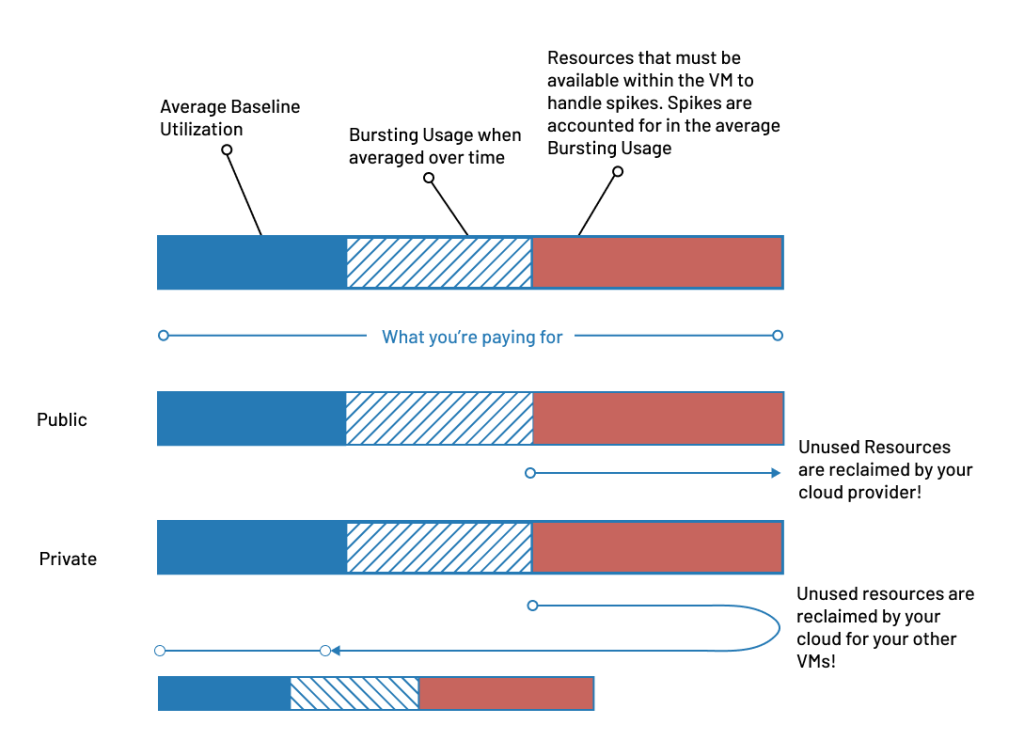A search on “public vs private cloud advantages” will nearly always include some statements about public cloud being “less expensive” than alternatives. Unfortunately, the common narrative of public cloud being less expensive is simply not true for many situations and not true for almost all large deployments!
More information about alternatives to public cloud is needed to help leaders in IT explain when public cloud is right or when private cloud, bare metal, colocation, or owned data centers are the right choice.
Don’t buy into the idea that public cloud is expensive?
- The Cost of Cloud, a Trillion Dollar Paradox report from Andreessen Horowitz
- David Heinemeier Hansson, the creator of Ruby on Rails and co-owner & CTO of 37signals (Basecamp and HEY) on Why we’re leaving the cloud
The Advantage of Private Cloud Resource Management
As a cloud provider that merges public and private cloud benefits – ie, private cloud at the speed of public cloud and with dynamic scaling – I find myself answering often why we chose private cloud resource management versus a public cloud approach. There are many reasons, but one is private cloud’s core advantage for the VM tenant – our customer. It can be a bit tricky to explain so we fired up one of our designers and he created a few graphics, that hopefully, helps answer the question.
The advantage of private cloud over public in this area comes from a basic fundamental difference. You are leasing all the resources of the hardware and not just the virtual resources. This means when you provision a VM you can provision the size you need, but during the time that VM is not spiking to consume the top level limit of the VM, those previously wasted resources are accessible via your private cloud software to be used by your other VMs! In public cloud, your wasted resources are often designed to be reclaimed by the public cloud to be resold to other users!
Private Cloud vs Public Cloud Resource Management from with a VM
Average Used Resources
Average Burst Resources
Wasted Resources

Next, let me address three key points:
- Public cloud for companies with small total workloads is absolutely a great choice. If you are interested in what is “small” and ways to understand when your tipping point occurs, check our A Cost Tipping Point Guide for IT Professionals: Public vs Private Cloud. The advantage I am speaking about comes in for companies that have reached their tipping point.
- The illustrative ratios used below (30%, 30%, 40%) are based from very large data sets over many years pulled from our public cloud and private cloud customers and from inbound customers from mega clouds. These ratios are aggregates and specific workloads will have different characteristics.
- Traditional private cloud has its own challenges including wasted resources that can eliminate any benefits. But modern private cloud providers have matured along with the rest of the cloud market. Using an OpenMetal cloud as a hosted private cloud is just one example.
As You Scale the Private Cloud Advantage Grows
At scale the resource management advantage becomes larger and larger in raw savings. A small deployment example of just 40 VMs can give you an idea of what is going to happen. Keep in mind that many companies use thousands of mixed size VMs or use hundreds of very large VMs. The costs can very quickly become significant. In particular, we created programs to help SaaS companies and Hosting and Cloud Providers that run on those public clouds to exit as they have found themselves with little or no profit just because of the cost of the public cloud.
Private Cloud

Public Cloud

Advantage of Private Cloud by Resource Efficiency
Restated for clarity – when you lease a VM from a public cloud, you must pay for a VM for a workload that will use roughly 30% of the resources on average and will burst to use, when averaged out over time, no more than 30% more. When averaged, this leave roughly 40% of the VM wasted.
Unfortunately, you must still lease this average wasted space by getting a much larger VM than your workload really needs. If you do not, your workload will run into limits periodically that will ultimately degrade your performance both at the rare, but critical times, your workload needs the full resources and at the times that the workload should already have finished but could not because it was delayed by resource constraints. Private cloud has a clear advantage here as it allows your resources to float back and forth between your VMs at no additional cost to you. It is clearly important to understand this new cloud deployment model.
Occasionally you may hear the idea that if there is so much waste in the VM why not add more workloads into the VM. That is certainly one of the options, but it also negates the key benefit of workload separation that is fundamental to cloud and virtualization. And your system admin team or your SREs will be very angry with you! Usage of Containers in VMs is a reasonably safe way to do this and is common already but typically for related parts of a single system. Kubernetes, for example, is very popular on OpenMetal – see our tech docs and our platform page but typically the various different Kubernetes Pods/Clusters are still kept away from each other by VM separation.
Please note that the above is for understanding of the system difference – your individual workloads may run at a much lower average rate or at a much higher average rate. Math modeling or graphics rendering pipelines that are run continuously have a much higher average usage – think 70%. The advantage of private cloud in this case will be less. Web servers, database servers, and application servers typically are roughly 25%. Software development pipelines are examples of workloads that typically have lower average usage – as low as 10% as these typically do not run continuously. For these two cases, your advantage with a private cloud will be very good.
Hope that helps and if you are in seeking alternatives to high cost public clouds please check out our hosted private cloud now selling in US East, US West, and EU Central.
Have questions? Chat With Our Team
Basecamp and Hey CTO on Why They Are Leaving The Public Cloud
Well-respected technologist David Heinemeier Hansson, the creator of Ruby on Rails and co-owner & CTO of 37signals (Basecamp and HEY) weighs in on their choice to “decamp” from the public cloud. And yes, guess what, they were facing huge bills from the public cloud and the panacea of the cloud turned out to just be a “wonderful marketing coup“.
I highly recommend reading this as he has offered up a real world story from a company that has experience in both running on the public cloud and running their own infrastructure. I am not sure their management system in their own infrastructure, but his message is very clear about exercising caution when it comes to the mega [public] clouds. They also published a follow up “Our cloud spend in 2022 ” that takes you deeper into the numbers.
“It was a wonderful marketing coup, though.“
David Heinemeier Hansson
Source: Why we’re leaving the cloud
“If you’re operating at scale, the cost of [public] cloud can at least double your infrastructure bill.”
Andreessen Horowitz
Andreessen Horowitz on the Cost Disadvantage of Public Cloud
It’s 2023 and many companies are facing huge pressure to trim back their infrastructure spend and to increase the value they are getting from those dollars.
As this pressure builds, companies must truly evaluate their cost of infrastructure and educate themselves on alternatives to high cost mega cloud providers. This shift reminds me of a contentious position put out by Andreesen Horowitz 2 years ago. They evaluated the damage done to their portfolio of investments from those portfolio companies’ usage of high cost public cloud.
Their position was clearly counter to the public opinion at the time, but certainly now appears to be simply ahead of the game.
That takes us to today. Companies are deeply entrenched, and rightly so, into the concept of “cloud”. But, it is important to be crystal clear that cloud is not a destination. It is an approach that can be implemented in many ways and not just by moving to a few “mega public clouds”.
On-Demand Hosted Private Cloud removes startup expense and risk and gives you the benefits of the private cloud immediately. We are excited to bring this product to market and invite you to explore a new option to be “in the cloud”.



































